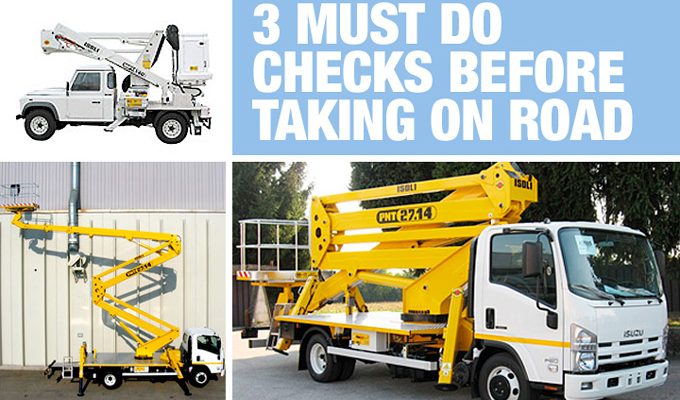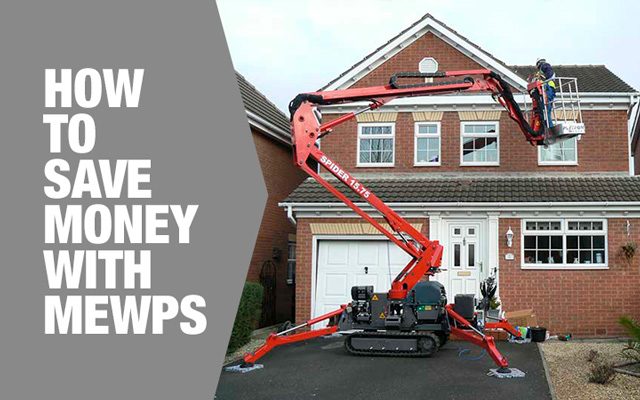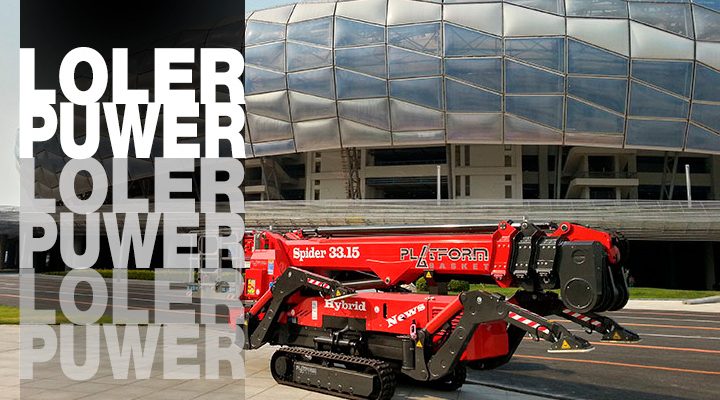
Three “must do” checks before taking MEWPS on the road
27 August 2017
Be aware of these regulations for MEWPs on the road
Vehicle and truck mounted access platforms are ideal for a wide range of jobs on and offsite and are able to move between jobs quickly and safely.
However, there are a few regulations to be aware of before taking MEWPs on the road. Make sure they are
First: road worthy,
Second: licensed and
Third: loaded safely to minimise the risk of over-tipping or subsidence.
There are two types of mobile access platforms
Vehicle mounted access equipment falls into two categories for vehicle excise duty and road regulations:
1. Up to 3500 kg Revenue Weight which are classed as light good vehicles
2. Over 3500 kg Revenue Weight which are classed as tower wagons
Light goods access platforms
• They can be driven on a Category B licence which is a standard car licence
• An annual MOT test is required once the powered access platform is over three years old and most vehicle mounted platforms may be too big for a standard testing centre but can be taken to an HGV vehicle testing centre instead
• Vehicles weighing between 300kg and 3500kg need a special class VII MOT test which are only available at HGV test centres and a limited number of standard ones
Tower wagon access platforms
• A category C1 drivers licence is required for platforms sized between 3.5 and 7.5 tonnes. Drivers who passed their car test before 1 January 1997 automatically have this entitlement but anyone who passed after this date needs to take a separate test to drive a vehicle over 3.5 tonnes
• Drivers of tower wagons over 7.5 tonnes must hold a large good vehicle licence
• Truck mounted access platforms are exempt from the Goods Vehicles (Plating and Testing) Regulations 1988 and the Goods Vehicles (Licensing of Operators) Regulations 1995, provided they are only used to transport the access platform
• Tower wagons must be roadworthy with a defect reporting system in place that includes records of all maintenance and servicing
SAFETY – Maintaining a safe weight
All mobile access platforms are subject to a Maximum Allowable Mass (MAM) which is the maximum weight that the vehicle that can be used on the road and includes the top weight that it can carry safely.
The MAM can usually be found on the vehicle, such as inside the driver’s door, or in the model operations manual. It is important that anyone using the access equipment is aware of the MAM as over loading the vehicle will have serious implications for stability and may lead to dangerous accidents. MAM is explained in more detail on the Government website.
Summary
It is always advisable to makes sure a powered access platform is safe to use and fit for purpose and for vehicle mounted access equipment, this also means making them road legal. Make sure you are aware what type of mobile access platform you are working with and the relevant road regulations and MAM limitations and, when used correctly, they can save time and money on a range of jobs at height by moving safely and swiftly between locations.

Your MEWP – make it work for you and save money
20 August 2017
Five easy ways your MEWP can work for you
Powered access platforms are flexible and ideal for a range of different jobs at height. They can save money for businesses of all sizes, whether they are used frequently or on a job-by- job basis.
Five ways that your MEWP could save your business money:
1) Buy or rent
Larger companies with multiple jobs at height can save on the rental costs by investing in their own equipment. With the extra advantage of being able to brand up their plant and train multiple operatives to use it, it is well worth considering. Owning your MEWP also allows flexibility in scheduling where and when it can be used across different projects.
Smaller firms can save money by renting access equipment as they go which saves on the initial expense of buying new equipment, on-going storage costs and the maintenance and servicing of a machine that they won’t get regular use out of.
If business improves and rental costs begin to accumulate then it may be time to look at owing your own MEWP. Before jumping in with a large capital outlay, look at the thriving market for second hand and used access platforms which are a cheaper option.
2) Time
Traditional methods for working at height such as scaffolding take time to erect and take down which needs to be priced into a job. There will be circumstances where this is the best option for the job but powered access platforms are the safest and quickest way to lift people and equipment to significant heights.
The access equipment can be brought to site, moved around if necessary and people lifted and lowered in a matter of minutes for a vast range of jobs. The mobility of access platforms also means they can be used for multiple jobs in different locations. More done in less time = saves money.
3) Safety
Falls from height account for most work-related accidents and the use of access platforms has shown significant reductions in the number of falls because:
• People are lifted in a cage and not required to climb
• Equipment is raised the same way and not winched up
• Safety harnesses are used on most jobs as an additional support
• Access platforms have excellent stability even on sharply sloping ground
• Current health and safety legislation means it is compulsory for all operatives to be fully trained in inspecting, operating and using access equipment and identifying potential hazards
4) Flexibility
Powered access platforms include a wide range of machines that have specialist features for different jobs and a variety of lift and outreach distances. Some machines such as boom lifts have the ability to reach over and around obstacles and others are able to operate off road and on all terrains.
If narrow doorway access is required, there are compact MEWPs available.
Selecting the correct equipment will save money by eliminating many of the potential problems and delays caused by using machines that are too heavy, inflexible or not fit for purpose.
5) Access
Access is essential to the success of many jobs at height and powered access platforms offer a solution to most working problems. For example, machines such as tracked access spider lifts can be used indoors or outdoors and are lightweight and adaptable for fragile ground surfaces. There are also duel function access platforms which can be driven on the road and on railway lines to reach difficult parts of the track. All-terrain vehicles that are four wheel drive and durable for use on ice, mud and sand are also available.
Summary
Often the cost of a job comes down to how quickly and safely it can be completed and how to cause the minimum disruption. Whatever the size of your business or the nature of your work, if you have to carry out jobs at height then powered access platforms can save you money. They are safe, easy to operate and fully mobile and flexible for a wide range of jobs and locations.

Essential Ground Condition Checks for MEWPs
13 August 2017
Ground condition checks for MEWPs
It may be sunny this morning but was there heavy rain last night and the night before that could mean unstable ground conditions?
Ground conditions are essential to the stability of powered access platforms and jobs at height are carried out on a variety of surfaces.
Different types of access equipment are suitable for use on a range of different surfaces, indoors and outdoors. Whether you are using an access platform on wheels or a jack or outrigger, choose the right type for the working surface. The weight of the access equipment could cause ground to shift mid-job which will make the machine unstable and risk falls or over-tipping.
How to perform ground checks for MEWPs
Ground Assessment – A visual inspection may be fine but some sites may need a full geotechnical survey . The assessment should be made by someone with enough knowledge and experience to bring in expert help if necessary.
Be flexible – Ground conditions can vary in different areas of the same site so be prepared to assess each individual location for the access equipment, especially when using mobile access platforms such as booms or scissor lifts.
Weather conditions – Wind, rain, ice and even sun can quickly change ground conditions and cause instability. Regular checks should be carried out, particularly in rainy or cold conditions, and adjustments made if necessary
Spreader plates – Most soils, unmade ground and some paved areas are not capable of supporting the high pressure created at the feet of outriggers.
Spreader plates should always be used with boom-type mobile elevating work platforms (MEWPs) when fully supported on their outriggers.
Spreader plates should be used with all other MEWPs that have outriggers unless a risk assessment indicates they are not necessary. Spread the Load!
Surfaces and different powered access
Tracked access platforms and scissor lifts are a reliable option for these surfaces:
• Streets, paths and gardens – Paved areas might look strong but could have been laid on weak ground or have shallow services underneath.
• Indoors – Many floors, cellars and basements are incapable of bearing the weight of access equipment so care must be taken when siting equipment indoors for a job.
All-terrain access platforms are best for any off-road work or surfaces that require specialist traction or 4WD:
• Sand – Low sand density and high or variable water tables can create difficult conditions on sand.
• Ice and snow – Regular checks should be carried out as frozen ground can quickly become soft as it thaws.
• Rural areas – Many rural areas require an off-road vehicle. Take extra care when working next to rivers, estuaries and flood plains.
Boom lifts or mobile access platforms such as vehicle mounted lifts offer the flexibility and variety of reach to tackle most jobs at height in urban environments:
• Urban streets – Take extra care when siting equipment on estate roads or areas that are used to light traffic rather than those used regularly by heavy commercial vehicles.
• Underground Services – Sewers, drains, manholes, gas and water mains can be close to the surface and may be damaged by the weight of a powered access platform or could even collapse and cause the machine to become unstable or overturn.
Summary
The key to using access equipment on different surfaces is to be flexible and prepared to keep checking the ground conditions in case there is any change. It is better to check and make adjustments than wait for problems to occur, especially as it is easy to adjust the stability settings of most access equipment. Make sure you have the right type of platform for the job and that your checks are carried out properly and regularly so the access equipment will do a safe job on most types of ground surface.

Do you know your MEWP Maintenance
6 August 2017
MEWP Maintenance And Safety Regulations
Powered access platforms are only safe and efficient if they are in premium working condition and regular inspections and MEWP maintenance are required by law for lifting equipment.
Making sure access equipment is stable, safe and fit for purpose is essential to health and safety and means jobs at height are completed faster and more efficiently. Whether it is a new or used access platform, keeping the access equipment in prime working condition extends its performance and lifespan and increases value for money.
There are two pieces of current legislation that govern MEWP maintenance:
• Lifting Operations and Lifting Equipment Regulations 1998 (LOLER)
• Provision and Use of Work Equipment Regulations 1998 (PUWER)
It is a legal requirement to make sure access platforms are tested and thoroughly examined at regular intervals by a qualified person – six months for anything lifting people and 12 months for machines lifting just equipment.
Lifting Operations and Lifting Equipment Regulations 1998 (LOLER)
LOLER has the following requirements for servicing access equipment:
• Equipment used for lifting people should be safe to use and all necessary precautions must be taken to eliminate or reduce any risk
• Access equipment should be thoroughly examined before it is used for the first time
• Examinations should be carried out in use every six months for access platforms lifting people and 12 months for all other equipment
• Inspections and servicing should be carried out by a qualified person who submits a full report to the owner/employer
See the HSE publication “Lifting Operations and Lifting Equipment Regulations 1998. Approved Code of Practice and guidance” for the regulations.
Provision and Use of Work Equipment Regulations 1998 (PUWER)
The servicing requirements of PUWER for work equipment are:
• It should be suitable for use
• It is used and maintained in a safe condition for use so that people’s health and safety is not at risk
• Inspected regularly to ensure that it is safe for use
• A competent person should carry our inspections and a record kept until the next inspection
• Mobile access platforms used for carrying people should be fit for purpose with measures taken to reduce the risks to anyone using it or in the vicinity
The HSE publication “Provision and Use of Work Equipment Regulations 1998. Approved Code of Practice and guidance” is available from their website here.
The Promax Access LOLER Reminder Service
Without a valid LOLER certificate, you should not use your machine. We offer a free LOLER reminder service to save you the problem of remembering your access platform’s (LOLER) examination.
See our LOLER reminder and simply enter the date of your next LOLER examination and we will not only contact you prior to that date, but also issue a LOLER reminder to let you know when it is due.
Summary
Powered access platform maintenance is important to meet regulations and maximise the functionality and safety of the equipment. To comply with LOLER 1998 and PUWER 1998, have access equipment tested and thoroughly examined at regular intervals by a qualified inspector or engineer.
Getting your powered access platforms inspected and serviced regularly is not only a legal requirement but a way to guarantee it is operating at peak performance, getting jobs at height completed faster and more safely and to avoid any unnecessary accidents.